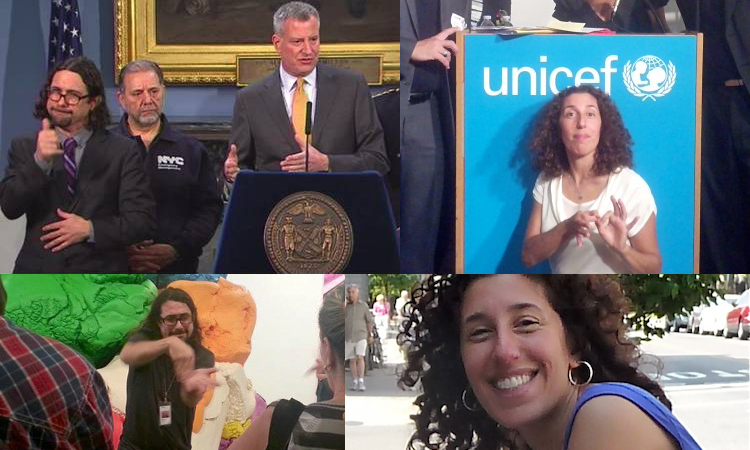
The hearing-Deaf duo who became an overnight social media sensation discuss their sudden fame, interpreting for the Deaf community, and the beauty and nuance of sign language.
Andria Alefhi and Jonathan Lamberton are interpreters for the Deaf community. Jon, who is Deaf, is a native user of American Sign Language. Andria, whose hearing is within normal range, considers ASL a second language. They rarely work together, but a recent televised gig for New York City’s Office of Emergency Management thrust them into the spotlight, when BuzzFeed, the Daily Show, and other media outlets made note of Jon’s animated presence. The longtime couple greeted his unexpected notoriety with good humor, but also stressed that his only goal was to communicate critical information as clearly as possible to a wide range of Deaf New Yorkers. When not on the job, Jon loves traveling back roads and backpacking in the mountains. Andria is the founder of We’ll Never Have Paris, a nonfiction literary zine.
On a Rewire Me Moment:
Andria: The 1985 TV movie Love Is Never Silent inspired me to buy a book and start teaching myself ASL from two-dimensional line drawings of basic signs. Children of a Lesser God cemented the deal when I was 16, an age when I needed something to belong to. I’ve found over the years that I wasn’t the only impressionable hearing person moved to learn ASL as a result of seeing that movie.
On Origins
Jon: My parents, my only sibling, and a paternal grandparent are Deaf. I was fortunate to grow up in a fully communicating environment where I socialized with many Deaf people and was exposed to Deaf culture and a variety of Deaf communication styles. I apply it all in my work as a Certified Deaf Interpreter. Governments have failed a percentage of the Deaf community who, although they sign, communicate in nonstandard ways because they basically never fully developed a language. I have special expertise and training to work with these Deaf persons.
On Loving What We Do
Jon: The best part is when clear explanation effects positive results. There was an isolated Deaf patient with diabetes who’d been declining for years, due to not understanding the necessary health and dietary precautions. After I became involved, the patient started to improve. I cherish happy results like that.
On New Vocabulary
Andria: Sometimes the choice that becomes the front-runner is not my preferred sign.
Jon: Yeah, like “Facebook.” Here in America, Deaf people mostly just summarize with the letters “FB.” Some other countries use the sign for “book,” but placed on the face. I don’t really like either solution. The sign for “Obama” isn’t bad—it’s like an “O” and then a “B” looking like a flag waving.
On Communication
Jon: Once I had some ice left over in my drink. I was chewing it, swirling it in the cup. A friend told me it was pretty loud, that everyone in the room could hear the ice crunching in my mouth and clinking in the glass. I realized I needed to be more aware of my actions when among hearing people.
On Communication, Part II
Jon: ASL allows for modifications of facial expressions and gestures to add inflections, adverbs, adjectives, and other stuff. A lot of these modification techniques are somewhat innate to sign language, as facial expressions and gestures with similar meanings are seen in many other sign languages. However, the actual signs themselves are much more variable. Without the modifications, ASL becomes more like English.
On Misassumptions
Jon: Everyone thinks there’s only one sign language. That couldn’t be further from the truth—most countries have their own sign languages. While Canada and America share ASL as a sign language, England uses a completely different sign language, incomprehensible to Americans. Interestingly, ASL is directly related to French sign language.
On Being the Messenger
Andria: Interpreting bad news is never easy. Recently I had to keep from crying on the spot.
Jon: Interpreting between a Deaf person and the archetypal “stupid DMV employee” in a serious medical or legal situation can be so frustrating. I have to remember I’m only there to interpret, and it’s not my message. I try to convey the correct tone and intent, however erroneous it may be.
Andria: Interpreting for a view I disagree with isn’t hard. I qualify it by raising my eyebrows and making a slight face. I want it clear that it’s not my view. Even though the client knows it’s not, I’ve gotta do something, you know?
Jon: It does suck when I know what needs to be done to fix a situation and yet I can’t do anything about it.
On What Not to Say
Andria: I was one of those people who learned ASL because I thought it was beautiful. Now I realize that I discredited the language and its users with my unnecessary fascination. The language exists whether outsiders learn it or not. When non-Deaf people tell me my interpreting is beautiful to watch, I thank them politely. My silent in-my-head reply is, “If you don’t know ASL, don’t watch me. You don’t know what I was doing at all.”
On Fluency
Jon: ASL is not easy, and while basic skills can be achieved in a year, it takes years and years to reach anything close to native fluency, going beyond signing the words and adding in all the facial expressions and gestures. It IS a beautiful and amazing language.
To find out about Rose’s thoughts on how to live a happier life, click here


